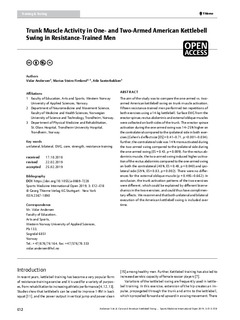Trunk Muscle Activity in One- and Two-Armed American Kettlebell Swing in Resistance-Trained Men.
Journal article, Peer reviewed
Published version

View/
Date
2019Metadata
Show full item recordCollections
- Import fra CRIStin [3604]
- Institutt for idrett, kosthald og naturfag [1006]
Original version
Andersen, V., Fimland, M., & Sæterbakken, A. (2019). Trunk muscle activity in one- and two-armed american kettlebell swing in resistance-trained men. Sports Medicine International Open, 3(1), E12-E18. 10.1055/a-0869-7228Abstract
The aim of the study was to compare the one-armed vs. two-armed American kettlebell swing on trunk muscle activation. Fifteen resistance-trained men performed ten repetitions of both exercises using a 14-kg kettlebell. Surface EMG from the erector spinae, rectus abdominis and external oblique muscles were collected on both sides of the trunk. The erector spinae activation during the one-armed swing was 14–25% higher on the contralateral compared to the ipsilateral side in both exercises (Cohen’s d effect size [ES]=0.41–0.71, p ˂ 0.001–0.034). Further, the contralateral side was 14% more activated during the two-armed swing compared to the ipsilateral side during the one-armed swing (ES=0.43, p=0.009). For the rectus abdominis muscle, the two-armed swing induced higher activation of the rectus abdominis compared to the one-armed swing on both the contralateral (40%, ES=0.48, p=0.040) and ipsilateral side (59%, ES=0.83, p=0.002). There were no differences for the external oblique muscle (p=0.495–0.662). In conclusion, the trunk activation patterns of the two exercises were different, which could be explained by different biomechanics in the two exercises, and could thus have complimentary effects. We recommend that both unilateral and bilateral execution of the American kettlebell swing is included over time.
